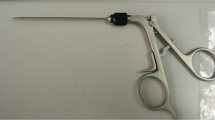Abstract
Many different techniques for laparoscopic inguinal hernia repair have been introduced recently, using either an intraperitoneal [1–3] or an extraperitoneal [4–6] approach. One of the main challenges is to obtain a complete circumferential closure of the sack at the level of the internal ring without injury to the adjacent vas deferens or spermatic vessels. In an effort to separate these structures from the peritoneum before passing a suture around the base of the sack, we developed the hydrodissection-lasso technique, which is performed using a single-incision endosurgical approach.
With the patient in Trendelenburg position, an 8-mm skin incision is made in the umbilicus, and a 5-mm trocar is placed in the inferior aspect for the endoscope. A 3-mm Maryland grasper is placed directly through the fascia in the upper part of the incision. Using a 22-gauge needle inserted percutaneously over the internal inguinal ring, saline is injected into the subperitoneal plane circumferentially, hydrodissecting the peritoneum off the vas deferens and vessels and creating a safe space through which the suture can pass without compromising these structures. A 2-mm stab incision is made directly over the internal inguinal ring, and a lasso technique is used to pass two strands of braided polyester suture around the hernia sack, as demonstrated in the video. Both sutures are tied tightly, leaving the knots under the skin. No direct or indirect manipulation of the vas deferens or vessels takes place during any part of the procedure.
In contrast to other described techniques [7], the hydrodissection-lasso technique can be used for all indirect inguinal hernias in both girls and boys, and hydrodissection itself may be a useful adjunct to any of the other aforementioned techniques. Although an age limit for exclusive high ligation of the hernia sack for indirect inguinal hernias has not been established, the recurrence rate may be higher for adults if the procedure is not combined with inguinal floor reconstruction [8]. At this time, we therefore limit the proposed technique to prepubertal patients.
We have performed the described procedure for 22 patients without any recurrences during a maximum follow-up period of 12 months (Table 1). The patients had minimal postoperative pain. There were no complications except for a transient genitofemoral nerve paresis experienced by one girl in whom the hydrodissection was performed using 1% lidocaine instead of the usual normal saline solution. Although the sack was not resected, there were no cases of postoperative hydroceles.
To evaluate whether this novel technique is an adequate long-term solution, a prospective clinical trial comparing standard open and single-incision endosurgical inguinal hernia repair using hydrodissection should be performed.
Similar content being viewed by others
References
Bharathi RS, Dabas AK, Arora M, Baskaran V (2008) Laparoscopic ligation of internal ring-three ports versus single-port technique: are working ports necessary? J Laparoendosc Adv Surg Tech A 18:891–894
Esposito C, Montinaro L, Alicchio F, Scermino S, Basile A, Armenise T, Settimi A (2009) Technical standardization of laparoscopic herniorraphy in pediatric patients. World J Surg 33:1846–1850
Giseke S, Glass M, Tapadar P, Matthyssens L, Philippe P (2010) A true laparoscopic herniotomy in children: evaluation of long-term outcome. J Laparoendosc Adv Surg Tech A 20:191–194
Dutta S, Albanese C (2009) Transcutaneous laparoscopic hernia repair in children: a prospective review of 275 hernia repairs with minimum 2-year follow-up. Surg Endosc 23:103–107
Ozgediz D, Roayaie K, Lee H, Nobuhara KK, Farmer DL, Bratton B, Harrison MR (2007) Subcutaneous endoscopically assisted ligation (SEAL) of the internal ring for repair of inguinal hernias in children: report of a new technique and early results. Surg Endosc 21:1327–1331
Tam YH, Lee KH, Sihoe JD, Chan KW, Wong PY, Cheung ST, Mou JW (2009) Laparoscopic hernia repair in children by the hook method: a single-center series of 433 consecutive patients. J Pediatr Surg 44:1502–1505
Guner YS, Emami CN, Chokshi NK, Wang K, Shin CE (2010) Inversion herniotomy: a laparoscopic technique for female inguinal hernia repair. J Laparoendosc Adv Surg Tech A 20:481–484
Beets GL, Oosterhuis KJ, Go PM, Baeten CG, Kootstra G (1997) Long-term followup (12–15 years) of a randomized controlled trial comparing Bassini-Stetten, Shouldice, and high ligation with narrowing of the internal ring for primary inguinal hernia repair. J Am Coll Surg 185:352–357
Author information
Authors and Affiliations
Corresponding author
Electronic supplementary material
Below is the link to the electronic supplementary material.
Supplementary material 1 (MPEG 152106 kb)
Rights and permissions
About this article
Cite this article
Muensterer, O.J., Georgeson, K.E. Inguinal hernia repair by single-incision pediatric endosurgery (SIPES) using the hydrodissection-lasso technique. Surg Endosc 25, 3438–3439 (2011). https://doi.org/10.1007/s00464-011-1713-2
Received:
Accepted:
Published:
Issue Date:
DOI: https://doi.org/10.1007/s00464-011-1713-2




